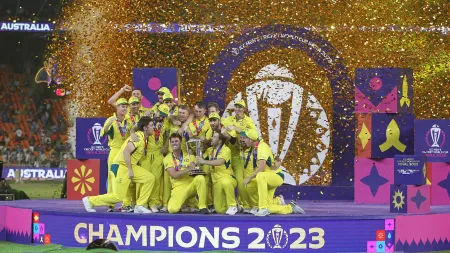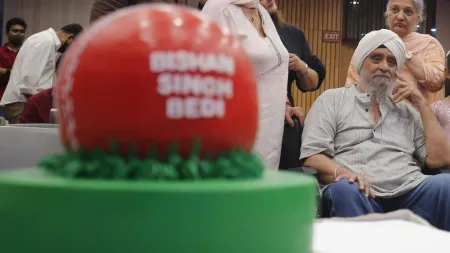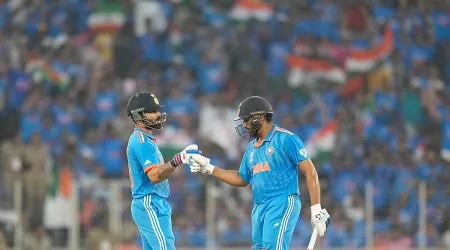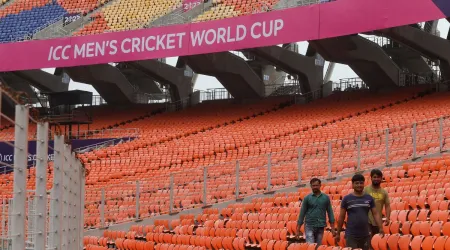- India
- International
Satwiksairaj Rankireddy-Chirag Shetty missing link on court: Defence counsel
Satwik-Chirag’s power-speed symphony is electrifying, but suspect defence can drag them down. The Indian Express writes about the missing link on court.
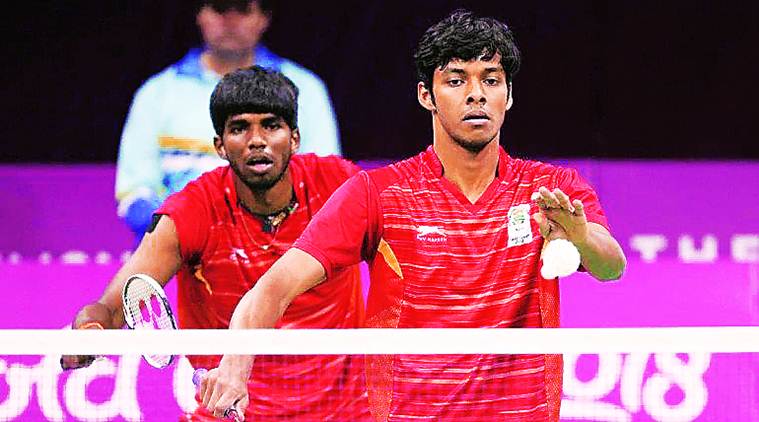 Ranked No. 8 in the world, Satwiksairaj Rankireddy and Chirag Shetty are among the world’s elite, except for the chink in their armour. (Reuters)
Ranked No. 8 in the world, Satwiksairaj Rankireddy and Chirag Shetty are among the world’s elite, except for the chink in their armour. (Reuters)
“Well, you can’t cut them up to shave some height off them as if they are wooden statues. They are two big human boys!” former doubles shuttler Leroy D’Sa rumbles like incredulous thunder, at the querulous suggestion that Satwiksairaj Rankireddy and Chirag Shetty are too tall for their own good. Their 6-foot frames are being dissected, and what’s a boon for their attack is clearly a bane in their defence.
Their fans are bullish, but India’s top doubles pairing can still not be called Olympic medal contenders. They have one of the world’s most lethal attacks, but that can get dragged down with their still-leaky defence.
Indian men’s doubles badminton has never had it this good. Satwik and Chirag are springing out of their early 20s, bouncing about in tournament arenas across the world, pushing the top pairings of the world all the way and creating a flutter of excitement every time they step onto the court for one of their electrifying skirmishes. This is not just about sniffing a medal at the Tokyo Games next year, though the murmurs have started. But what the pair has refreshingly done for Indian badminton is offer edge-of the-seat entertainment, win or lose, whenever they play.
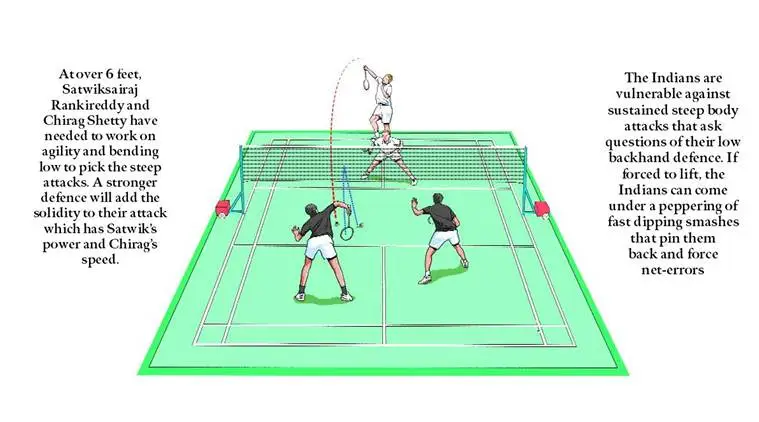 (Illustration: Suvajit Dey)
(Illustration: Suvajit Dey)
Parisians were charmed, Bangkok was beguiled, Fuzhou in China was captivated this season. And last year at the iconic Istora during the Asian Games, home favourites, the immensely brilliant World No 1s, Marcus Fernaldi Gideon and Kevin Sanjaya Sukamuljo, were given an almighty scare — the Indians led 19-18 in the second after winning the first game — as the Indonesians dinned and drummed on their favourite ‘Minions’, kept teetering by the then-unheralded Indians.
Never has an Indian pairing in badminton looked like it’ll ambush the sport’s reigning divinities in doubles – the Indonesians, Koreans, Chinese and Danes, and do it with such bombast while breaking through the doubles clutter. India has joined the high-voltage action of badminton that typically creates blasting decibel at Asian cauldrons and European arenas alike, as the paired funambulists dive and dazzle in high-speed smash-fests that shoot up adrenaline levels.

Satwik has a screaming big smash from the back, and Chirag the clever interceptions as he streaks across on court. The Indians ranked No. 8 now are right up there among the world’s elite, except for that chink in their armour. What can send this power-speed symphony off-key is the duo’s suspect defence. “It’s not bad; if it was bad, they wouldn’t have reached where they have. If their attack is 8 or 9, defence is 6 or 7 on 10 — not as good as their offence. It’s good but not good enough to withstand an onslaught of steep smashes raining down on them,” D’Sa says. Bending low to pick shuttles, many which dip as low as three feet, is key to cracking this code, but of course like D’Sa roars, there’s nothing to be done about their tall frames.
Crouching tigers: hidden canon
Drilling holes into the opponents’ defence is something the Indians used masterfully against the top Chinese pairing, Li Junhui and Liu Yu Chen, two men upwards of 190 cms. Doubles is where you get as good as you dish out. So, the one vulnerability in the Indians that rivals have exploited is the sustained assault that comes down steeply on their bodies — below the waist.
It can rain down on anyone, and invariably does. But at the top-most level, seasoned pairings plug their defences with smooth backhand parries with the racquet head impeccably pointed south and the elbow jutting out in a straight line from the shoulder blades. These are low retrieves, often needing patience and pliable body positioning, while not allowing the lollipop of a limp lift for opponents to kill with a smash. All this happens at breakneck pace, and as India is still a novice at the topmost level in men’s doubles, it’s yet to imprint these drills into muscle memories. To top it, India’s best practitioners are two hulking tall men.
What is being attempted is to bring their centre of gravity as low as possible, so that their impressive attack is not compromised by the inhibiting defence.
London Olympics silver medallist Mathias Boe of Denmark had one good look at Chirag four years ago while training with him in Mumbai, and told him that he’s standing on two stiff legs which are wrecking his defence. In close, tense matches, both Indians have faced the rampage, that tested their defensive capabilities and put paid to a beautiful rally in which their offence had held sway. But three low birds, coming down thick and fast, and chances were the fourth would be flubbed into the net, undoing all the good attacking work.
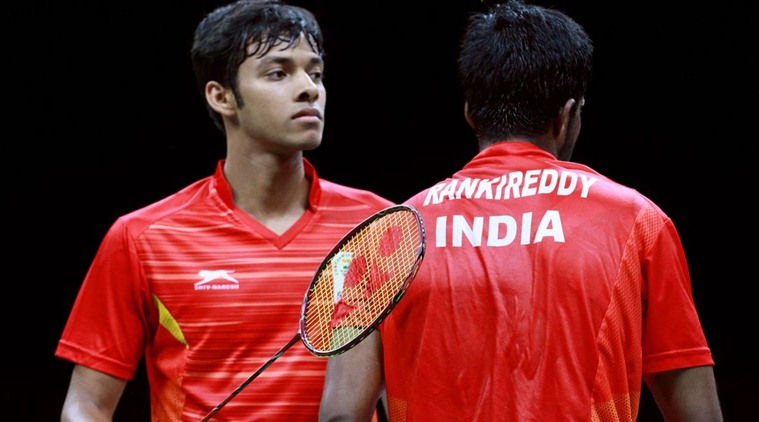 (Reuters)
(Reuters)
The champion Indonesians — Kevin and Marcus — who have a whiplash fast game to start with which then morphs into some outrageous stroke-making, have denied the Indians all these years finding those low dipping projectiles at opportune times to quell their challenge.
“Their defence is probably one of the weaker aspects of their game. Both are really tall players and it is a little bit difficult in the defence to bend your knees. It takes a lot of energy and power to just stand low and be able to move your feet quickly,” Boe, 39 and one of Denmark’s finest doubles shuttlers, says.
“Whenever I practise with Chirag, it’s one of the things I keep telling him: that you need to bend your knees and be more agile. And be more alert, and ready to push forward,” Boe says.
Some seemingly unrelated factors can come into play. “Of course being tall is a little bit of a disadvantage in defence. But it’s also a cultural thing and the times I’ve practised in Hyderabad, it’s extremely humid and warm. It’s very difficult to practise your defence in there because you feel like it’s a tennis ball your opponents are smashing at you. So maybe that’s why when you have those shuttles, it’s extremely difficult to control the defence. At least that’s how I experienced it,” Boe says. “Whereas when you play in China, Denmark and some of the colder places, the game is a little bit slower and it helps their defence. But that’s something they need to improve.”
While they can scarcely help the conditions and definitely not their long limbs, Boe insists that the two will need to strengthen their legs, not too dissimilar to singles players like HS Prannoy or Viktor Axelsen, who too confront this problem.
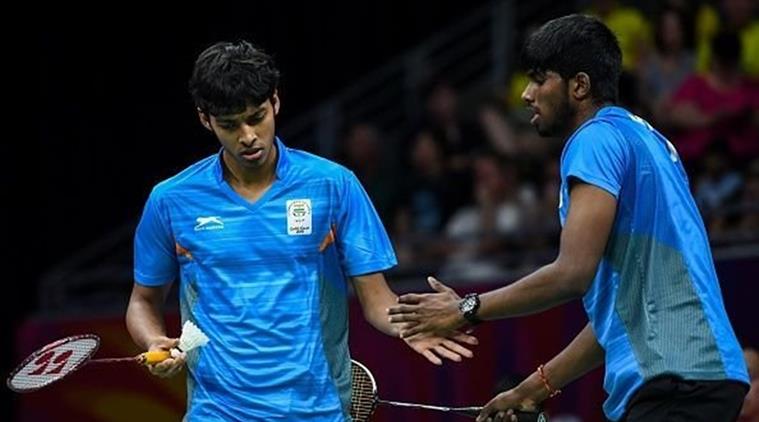 Satwik-Chirag lose French Open final. (Source: BAI Twitter)
Satwik-Chirag lose French Open final. (Source: BAI Twitter)
“Look, defence is more difficult when tall,” says the Dane, himself 6’1 like his partners Carsten Mogensen and Mads Conrad-Peterson, but having seen a long line of Danish giants take on the challenge. “It’s tougher for tall players to stand with bent knees and push off from there… and you need lot of muscles in your legs and need to be really strong.”
Chirag is aware it’s the missing link, and there’s no props for badminton’s bread-and-butter activity of picking shuttles slammed into the body. “It’ll need mainly more and more hours of hard work that we put in. And stronger legs, since we have to bend around quite a bit and defend in squat position,” he says.
It’s one of those parts of the game with incremental improvements, and where they are susceptible to a bad day at the office. “We are still not that consistent in our defence. I think it won’t happen in a day or two. But we’ve come a long way since we started. We’ve been defending extremely well. It can get better. Our attack is definitely one of the best, but the defence is not up to the mark. And if we want to break into the top five next year, we have to improve our defence,” Chirag states.
Long road till here
It was a pairing with plenty of teething troubles technically, because both started out playing the big-boom game from the back court. Urged to move in front though the two rotate smoothly, Chirag, 22, knew he had to learn a fresh set of skills at the net considering he was accustomed to the dramatic full-swing of the racquet from the back. Controlled, checked movements at the net were a whole new syllabus.
While the Indians won their first title in Thailand playing a masterfully taut parallel game to deny the Chinese any smashing room, Chirag was priming to create openings from the front.
Suddenly the 6’1” was plonked at the net, with his bobbing head at least 1.5 feet higher than the tape and knees having to crouch and get into position for the second stroke right after the serve and the body having to arch into a destabilised ‘C’ to parry off the body attack. Boe would help him hunker down, literally.
He would also find inspiration in Indonesian Mohammed Ahsan, a brilliant tactician who varied his pace and changed direction mid-attack. For effective transitioning in turning defensive returns into cross attacks, he would look at videos of Chinese former No 1s Cai Yun and Fu Haifeng to observe how they moved. “The front court game is not like increasing strength. You need to be lot more creative even when defending and constantly look to set it up,” Chirag says.
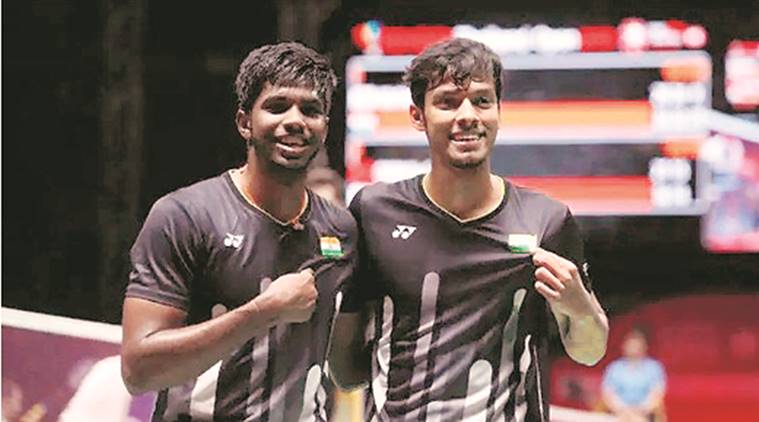 Satwiksairaj Rankireddy (L) and Chirag Shetty shocked reigning world champions Mohammad Ahsan and Hendra Setiawan 21-18, 18-21, 21-13. (File)
Satwiksairaj Rankireddy (L) and Chirag Shetty shocked reigning world champions Mohammad Ahsan and Hendra Setiawan 21-18, 18-21, 21-13. (File)
Satwik, a cool cat on court, unflappable at most times, faces his own struggles through the agility drills, but tends to be calmer on defence, and less error-prone (though only marginally.)
Moreover, given his smashing shoulder needs to do the literal heavy lifting and is always up for judging, the big man from Amalapuram finds the low retrieves relatively less stressful. He’s not too frazzled at any rate, though he’s had his share of defensive misses if the Indians fail to keep the shuttle down, and get drawn into a lob-game. At any rate, Satwik lets off steam by peppering opponents with his biggies when things get too tangled. But he has the big escape route kill at his disposal.
Chirag’s temperament though, is up for closer scrutiny.
In the last decade, India’s top pairing were the hardworking and earnest — but hugely limited — combination of Sanave Thomas and Rupesh Kumar.
Rupesh reckons it was impossible to prepare in training for the kind of intensity of attack that top-grade badminton can unleash. None in sparring could simulate that pace, he says. What works for India’s freshly minted pair is that they started young (“they have 6-8 years of top-flight game ahead”), played bucketloads of international matches and have time to bring their defence up to scratch to make their attack more lethal.
“As a start they are doing well to keep everything low, so they are not opening themselves up to attack. But they are such a talented pair, I want them to have a weapon in defence if nothing works,” Rupesh says, excited to watch the youngsters from India with immense possibilities soar.
While Rupesh insists that he’s never seen them look inexperienced or flustered on the big stage, and confident in their speed– power combine, the Indians are still new off the blocks. “When we played, we were catching up with opponents every single time. Opponents from China, Indonesia were naturally stronger and given the sparring we had, we practised, but when you played on court, it was just another level. It’s exciting to watch these two on par with others in attack. Defence will improve,” he says, genuinely excited about how they could shape up. “Defence just needs belief at crucial points and some luck in crunch moments.”
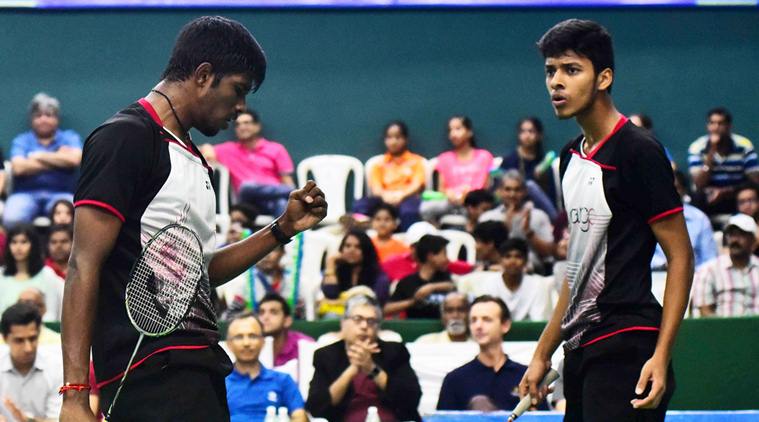 For the first six months Satwik and Chirag struggled to play as a pair as their personalities are as different as chalk and cheese.(Source: Express Photo)
For the first six months Satwik and Chirag struggled to play as a pair as their personalities are as different as chalk and cheese.(Source: Express Photo)
Defence earlier meant playing steady and not giving away points. Coach Uday Pawar, who combined with Prakash Padukone and mentored Chirag through his junior years, leans on a cricketing corollary. “Defensive shots must translate into attack. Like in cricket, you can’t block every ball, you need to rotate strike. So they need variety in defence, not just the block,” he says. Countering is as important as playing in gaps forcing opponents to lift.
In Thailand, the Indians kept pushing flat, even if it was three-feet high smashes, these were pushed on to the body and for variation, the next one went away from the body, to take the sting out of the attack while defending. The two prefer to get on with it on fast courts and play the full force of their imperious attack. But they will need to practise in slow conditions where rallies stretch endlessly and defence get perilous with each subsequent stroke.
“Their strength is attack on fast courts. It’s like fast bowlers in English conditions where they are effective; but on slow and low Indian wickets, you need to be more disciplined and consistent,” Pawar says. Unglamorous defence is what he is referring to.
Each of the three components of defence – the blocking jab, the push past the forecourt opponent and the least-risky lift will need to be honed further. So beyond holding fort to contain, the angle of the racquet in defensive strokes will need to get precise, and the third or fourth stroke would need to be a counter to break the momentum of steep downward attacks – like cross returns.
The ‘Maximum Minions’
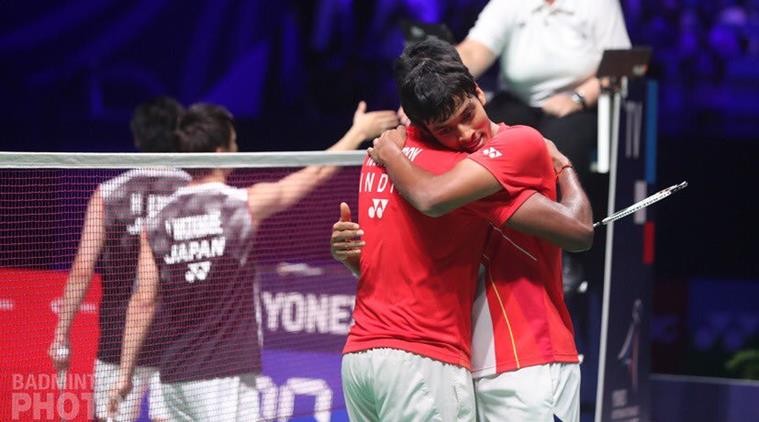
The 0-8 scoreline hangs enticingly on the scoreboard: the Indians have never beaten Kevin-Marcus, the world’s best pairing at the moment. While the Indonesians kept the Indians quiet at the net in Europe last month, the Indians have managed to push them back at times, and target Marcus. It might not amount to a mental block though the 0-8 margin doesn’t look pretty, but the Indians can’t hope to beat the dazzling duo till the defence is propped up, and they can shirk off the pressure and perhaps pick the opening game — like at the Asian Games — to get a toe-hold.
Kevin Sukamuljo does things no one can. He has singlehandedly pushed Chirag into backroom bending drills to be prepared for his sorcery. As such, the Indonesians divide the roles the same way as the Indians – one creates, the other kills. “Kevin is just a tad better and when you are up against him, it’s relatively easy to look quite stupid on court because he can just do some things that you don’t expect him to do and that you can’t really practise for daily. So you are not used to the sort of pressure he is putting on you,” Boe explains. When the Danes did beat them, they leant on defence. “Times I’ve beaten Kevin and Marcus, we have a more defensive style against them, make them work, make them a little tired and see if you can push forward a little and control the serve and receiving game and then eventually kill it. But it’s not an easy task. It sounds a lot easier than it actually is.”
“Satwik-Chirag definitely have the force to be able to beat them and it’s just a matter of time,” the Dane says. “Beat them once and maybe get the confidence to beat them more frequently.”
So, though attack defines the Indians’ game, it will need to be defence that can break the Indonesians.
What the Indians have kept at is improve the stamina, so exhaustion isn’t an interfering factor.
Earlier this year, national coach P Gopichand got deeply immersed in the doubles programme to define its broad contours: “our style and character, own culture of doubles… science-driven and intelligent”
Indonesian coach Flandy Limpele, in fact, put them through one royal wringer. “Oh! it was a nightmare with eight coaches waiting on eight adjacent courts for multifeeds, and we had to hop from one court to the next defending with a break only after two-and-a- half minutes. A rally is usually 20-30 seconds, or max 45 seconds. Here we’d go up to one minute. Smash, smash-tap, smash-drive, multi-rotation, start again.” That was for stamina. Long runs twice a week is not uncommon to build that base. “And combine it with agility and shadows. So it’s almost four days of endurance and speedwork training and agility.”
Gopichand, though, isn’t too fussed about defence. “I would love to see them get more aggressive and more pumped up. I know they have another gear up in them,” he says. While their backhand defence might be a worry, he insists, the third stroke is still an area of concern. “Defence is the easiest of the lot — they’ll keep improving. Is it an area of concern? No. The serve height can be a problem.” Their defence has its own strong defenders.


















